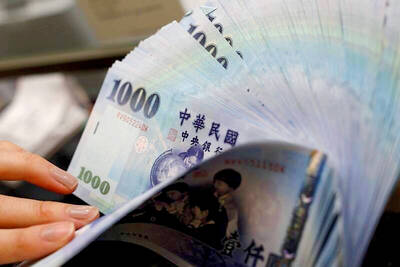China Southern Locomotive (中國南方機車), the country’s biggest train manufacturer, saw its shares peak in their trading debut yesterday at 83 percent above the initial public offering (IPO) price and then fall back as the broader market extended its losses.
By midday, the state-run company’s shares were at 3.68 yuan, down from the high of 4 yuan reached early in the day. The shares were down 4.7 percent from their opening price of 3.86 yuan but still about 77 percent above the IPO value.
China Southern Locomotive priced its IPO of 3 billion yuan-denominated shares at 2.18 yuan (US$0.32).
The debut did little to brighten sentiment on a market that has lost 55 percent of its value since the beginning of the year. The benchmark Shanghai Composite Index was down 3.1 percent midday yesterday at 2,373.56 in a decline led by refiners and other large capitalized shares.
“It’s not the best time to be putting IPOs on the market these days,” said Zhang Jincan, an analyst who focuses on the machinery industry, at Guotai Junan securities (國泰君安證券) in Beijing.
But given the strong growth planned for China’s railways in the coming years, the share’s price is in a “rational range,” he said, noting that efforts to curb inflation by keeping tight controls on construction investment were unlikely to adversely affect its business.
By the end of last year, China had spent less than a third of the 1.25 trillion yuan (US$187 billion) it had budgeted for railway expansion for 2006 to 2010, said Jing Ulrich, chairwoman of China equities for JPMorgan Chase & Co.
Together with a tandem listing on the Hong Kong Stock Exchange later this month, China Southern Locomotive’s IPO raised about US$1.5 billion — a far cry from the mega-listings of last year.
Research firm Dealogic has reported that this year Chinese markets, including Hong Kong’s, have seen new share listings plummet to a total of US$22 billion raised in 109 issues so far, down from US$45.1 billion worth of listings in the same period last year.
Meanwhile, share prices in both Shanghai and the smaller market in Shenzhen have languished — dogged by pessimism over the economy and earnings prospects for companies likely to see sales fall as demand for products declines in the US and other countries battling recession.
The pace of IPOs in China’s markets has slowed to a trickle. The China Southern Locomotive listing is the first in months and despite its relatively modest size the third largest this year.
The 6.54 billion yuan raised in the Shanghai segment of China Southern Locomotive is about 10 percent of the 66.8 billion yuan oil and PetroChina (中石油) netted in its Shanghai IPO last October — a record for a China exchange.
The two larger China IPOs so far this year, those of China Railway Construction Corp (中國鐵建) and China Coal Energy Co (中煤能源), raised US$5.7 billion — the second biggest worldwide so far this year — and US$3.5 billion respectively.
China’s markets were set up to raise money for state companies. But the protracted correction is causing some major players to defer domestic IPOs — among them China Mobile (中國移動), which late last year had been expected to raise as much as US$10 billion in a Shanghai share listing.

Merida Industry Co (美利達) has seen signs of recovery in the US and European markets this year, as customers are gradually depleting their inventories, the bicycle maker told shareholders yesterday. Given robust growth in new orders at its Taiwanese factory, coupled with its subsidiaries’ improving performance, Merida said it remains confident about the bicycle market’s prospects and expects steady growth in its core business this year. CAUTION ON CHINA However, the company must handle the Chinese market with great caution, as sales of road bikes there have declined significantly, affecting its revenue and profitability, Merida said in a statement, adding that it would

MARKET LEADERSHIP: Investors are flocking to Nvidia, drawn by the company’s long-term fundamntals, dominant position in the AI sector, and pricing and margin power Two years after Nvidia Corp made history by becoming the first chipmaker to achieve a US$1 trillion market capitalization, an even more remarkable milestone is within its grasp: becoming the first company to reach US$4 trillion. After the emergence of China’s DeepSeek (深度求索) sent the stock plunging earlier this year and stoked concerns that outlays on artificial intelligence (AI) infrastructure were set to slow, Nvidia shares have rallied back to a record. The company’s biggest customers remain full steam ahead on spending, much of which is flowing to its computing systems. Microsoft Corp, Meta Platforms Inc, Amazon.com Inc and Alphabet Inc are

RISING: Strong exports, and life insurance companies’ efforts to manage currency risks indicates the NT dollar would eventually pass the 29 level, an expert said The New Taiwan dollar yesterday rallied to its strongest in three years amid inflows to the nation’s stock market and broad-based weakness in the US dollar. Exporter sales of the US currency and a repatriation of funds from local asset managers also played a role, said two traders, who asked not to be identified as they were not authorized to speak publicly. State-owned banks were seen buying the greenback yesterday, but only at a moderate scale, the traders said. The local currency gained 0.77 percent, outperforming almost all of its Asian peers, to close at NT$29.165 per US dollar in Taipei trading yesterday. The

The US overtaking China as Taiwan’s top export destination could boost industrial development and wage growth, given the US is a high-income economy, an economist said yesterday. However, Taiwan still needs to diversify its export markets due to the unpredictability of US President Donald Trump’s administration, said Chiou Jiunn-rong (邱俊榮), an economics professor at National Central University. Taiwan’s exports soared to a record US$51.74 billion last month, driven by strong demand for artificial intelligence (AI) products and continued orders, with information and communication technology (ICT) and audio/video products leading all sectors. The US reclaimed its position as Taiwan’s top export market, accounting for